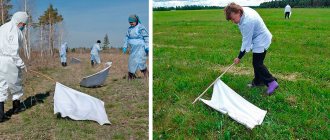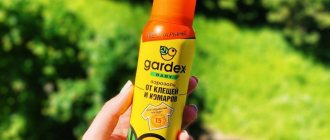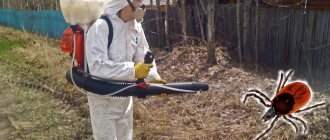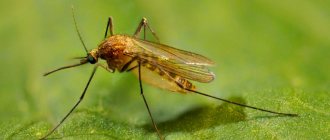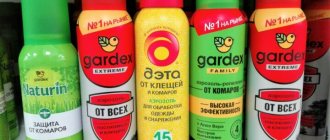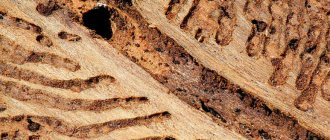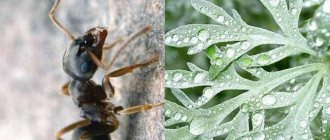This material provides a comparative analysis and recommendations for choosing a means of treating an area against ticks from the TOP-13 best preparations. Knowing their composition, release form and basic properties, it will not be difficult to choose a suitable product and treat the area yourself.
In addition, a STEP-BY-STEP work plan for self-treatment of the area from ticks :
- how to determine whether there are ticks on the site;
- how to determine the type of tick;
- how to choose the necessary drug and prepare a working solution;
- what security measures should be taken;
- how to carry out the processing itself and check its results.
Risk factors and measures to ensure protection against ticks are also considered .
Prevention: how to deal with ticks?
Obviously, it is impossible to eliminate all ticks in the forest, but treating a summer cottage is a feasible task. To begin with, it is worth making it uncomfortable for parasites to live in.
- Ticks love uncut grass, but they do not like trimmed lawns and paths with crushed stone or paving stones.
- Insects live in the shade and hide from the bright rays of the sun.
- The parasites move little and mostly wait for a passing victim.
- The tick senses its provider by thermal radiation and settles in advance where a person most often happens: on the grass or bushes near a bench, gazebo, washstand, or near the porch of a house.
If your dacha borders an abandoned area, or is located near a forest or field, animals or birds may bring insects from there. To block the path of ticks, it is recommended to mow the grass in the area, or at least along its perimeter. The tick senses prey 20 meters away; infected ticks have higher search activity. And, although he moves 10 meters per day, if nothing stops him on the way, he will independently reach the so-called feeder.
Last year's leaves, grass and plant tops should be collected in a compost pit, burned or buried. Ticks lay eggs in it. Paths and areas around benches and rest areas should be covered with gravel or sand. A concrete pavement around the house and outbuildings will prevent insects from entering the house and hiding there.
Reasons for the appearance of ticks in a summer cottage
The following can be distinguished:
- Food shortage, stimulating the search for new places. In a day they can cover distances of 10 m to find food.
- Placing a summer cottage near a forest.
- The appearance of parasites among neighbors.
- Bringing them in with the help of pets.
- When purchasing a plot, there is a risk of ticks. If they appear after 18-24 months, they were present initially, since their eggs mature during this time.
How to repel ticks?
Folk repellents that are safe for humans and animals are, first of all, plants with a characteristic intense aroma. Ticks don't like the smell:
- tansy;
- mint;
- marigolds;
- sage;
- thyme;
- rosemary;
- lavender;
- geraniums;
- garlic;
- pharmaceutical chamomile.
A hedge around the perimeter of the site will repel harmful insects. If you did not have time to plant these flowers and plants, you can spray a solution of essential oils with water throughout the area. In addition to the oils recommended for planting, eucalyptus oil is used. Obviously, spraying the area will take a lot of time and treatment will have to be carried out constantly.
Prevention of tick infestation of a summer cottage
By performing a number of actions, you can protect your area from arthropods. These include:
- Removal of waste from the territory.
- Treatment of pets' fur with a special product and a thorough examination of them.
- Planting repellent plants.
- Systematic cleaning of the ground from stale branches and grass, regular mowing of the lawn.
- Installation of bird feeders (starlings, thrushes) - natural enemies of ticks.
- Elimination of rodents - the main carriers of insects.
- Creating an obstacle near the fence itself in the form of a path made of sawdust or gravel 100 cm wide. This structure will prevent neighbors from entering the territory.
How to protect your site?
If you removed a tick from a pet, or noticed it in the grass, then you need to move from prevention to active control of insects. Methods of controlling ticks are divided into mechanical and chemical. The first one can be practiced independently, the second one is better left to professionals.
Mechanical method
The mechanical method involves collecting ticks from grass and bushes. A piece of white fleecy fabric the size of a pillowcase is secured to a long stick. The cloth is passed over the surface of the area in the morning or evening, when there is no bright sun. To make insects more willing to cling to the fabric, it is recommended to soak it with sweat.
The fabric along with the insects is burned. Killing ticks with your hands is dangerous: if they are infected, you can become infected. Place the cloth with insects in a metal basin or on a sheet of metal, pour kerosene on it and burn it without hesitation.
Chemicals
Any chemical preparation for treating summer cottages, gardens and vegetable gardens against ticks is, by definition, not safe. Violation of safety measures and instructions may threaten the life and health of people and animals.
Treatment with chemicals is carried out at least 40 days before the expected harvest and the fruits and vegetables that enter the treatment area are thoroughly washed.
It is necessary to correctly calculate the dosage so that it is effective in eliminating ticks and acceptable for the person who will spray the chemical. The area is thoroughly sprayed, especially the lower branches of plants and bushes. The grass is mowed and removed before processing.
Ticks are killed with insecticides, acaricides and insectoacaricides:
- DDT is a dust that is extremely toxic and accumulates in the soil.
- Organophosphorus compounds are toxic; if they come into contact with the skin, they cause poisoning. Upon contact with soil and air, they are quickly neutralized, breaking down into low-hazard elements.
- Pyrethroids are the safest substances; after treating the area, they quickly decompose.
Review of chemicals
Today, the following products are considered the most common and available for purchase:
| Sipaz-super | Kills ixodid ticks, mosquitoes, bedbugs, fleas, flies and cockroaches. Active ingredient: cypermethrin. The drug has no pronounced odor, the residual effect lasts up to one and a half months. |
| Cifox | Effective against ixodid and scabies mites. Kills ants, fleas, and flies. The effect lasts up to 3 months. It is made on the basis of cypermethrin and has a specific odor. |
| Titanium | Used by gardeners to prevent fungus and other plant damage. Made from propiconazole (pesticide, fungicide). |
| Force site | Kills ticks of all types, has a rich odor, and disappears quickly. Made on the basis of fenthion, low-hazard to humans. |
| Acaritox | A substance based on alphacypermethrin kills ixodid ticks. Protection lasts up to 1.5 months. Low danger to humans. |
Features of the use of chemicals
Tick control products are sprayed with a garden sprayer or hand sprayer.
When treating an area using liquid chemicals, the following protective equipment is required:
- headdress;
- safety glasses with wide lenses that fit tightly to the face;
- respirator for respiratory protection;
- overalls: robe and trousers covering the entire surface of the body. After processing, workwear must be removed and ventilated, and then washed.
- Rubber gloves or leggings.
Treatment should be carried out in dry, windless weather, on a moderately sunny day. Pets, children, people with allergies and food should not be in the treatment area.
Chemicals should not be allowed into wells, drinking water sources or bodies of water.
Bees and fish die from some drugs; this must be taken into account when choosing a means of treating an area.
When treating an area against ticks, correctly calculate the dosage and the appropriate preparation. Otherwise, you risk poisoning and putting family members in danger. Even chemists invite specialists to treat garden plots against ticks. They do this precisely because they correctly assess the risks of inept use of chemicals.
Correct processing algorithm
Treating the area against ticks
Treatment against ticks is called disinfestation, the drugs are called acaricides. Each product comes with instructions that you should first read. It is imperative to adhere to the recommended dosage and dilute the composition in the specified proportions.
There is a wide choice of how to spray an area against ticks. You can buy the drug in a specialized store, from special services employees, or order it online. Anti-mite treatment is carried out using a household spray bottle or a spray bottle.
It is necessary to spray the land in calm weather to prevent the poison from spreading in a random direction. The spray bottle should be directed in the direction of the wind so that the spray does not fly towards the person. You need to cultivate the soil, garden, and grass early in the morning or in the evening. You also need to monitor the weather. Precipitation during the first three days after disinfestation reduces the effectiveness of the drug; re-treatment will be required after 7-10 days.
Important!
The garden needs to be treated in early spring before the leaves bloom. At such a time, ticks are not yet active; the poison will not allow them to begin full-scale colonization of the territory. During the flowering period of trees, tick baiting is prohibited. The poison is deadly to bees and other insects that pollinate plants.
It is allowed to treat a suburban area at any time, but ensure that the use of poisons does not cause harm to the environment. In nature, products are used to treat the area 3 days before you plan to go on vacation.
Personal protection against ticks for people and pets
If an area is cleared of ticks, this, alas, does not mean that you are protected from them elsewhere. Therefore, when going for a walk in the forest, on the field or to the lake, apply repellent sprays to your clothes: “Off!”, “Medelis”, “Reftamid-MaximumExtreme”. Process the edges of the clothing - cuffs, trouser legs, collar. Do not spray the mixture in your face or inhale it.
As soon as you return from a walk, undress, shake out your clothes outside and carefully examine your skin to make sure that you are not wearing ticks.
Pets are often victims of ticks. It is recommended to combine a flea and tick collar with the application of anti-tick medications: Frontline, Bolfo, Proposkur. Before purchasing, read the instructions: not all drugs can be used for pregnant animals and young animals.
Traditional methods of eliminating ticks
To prevent blood-sucking parasites from populating the area, you can do the following:
- put a fence around the territory as protection from stray animals;
- install traps, traps and poisonous baits for rodents;
- mow the grass, remove old branches, clear the bushes, cutting off the branches at a distance of 50 cm from the soil;
- Have picnics from time to time, as smoke kills pests;
- plant the entire perimeter of the site with fragrant plants - calendula, marigolds, peppermint.
Treating your body, rather than the area, with cologne, essential oils, and repellents is no less effective. Bloodsuckers are afraid of smells.
If the owner of the dacha himself is unable to cope with arachnids, he will have to hire specialists. Services use modern equipment and strong insecticides.
What to do if a tick gets stuck?
When a tick lands on the body of its host, it begins to look for the most convenient place: the scalp, skin behind the ears, armpits, groin area. There is delicate and thin skin with many superficial blood vessels.
Usually a person does not feel how the tick bites: the insect’s saliva contains an analgesic, this allows it to quietly attach itself to the vessel and drink blood. After some time, swelling and thickening at the site of the bite becomes noticeable. It is impossible not to notice the body of a tick, but, unfortunately, this can happen when the insect has already bitten into it.
You should not remove the parasite yourself. The doctor will do this quickly, painlessly and immediately send him for examination. If necessary, the victim will immediately be given an injection of anti-tick immunoglobulin.
If it is impossible to get to a doctor, you need to eliminate the tick as soon as possible. If it is infected, remaining at the site of the bite will increase the risk of infection.
Hold the insect's body as close to the proboscis as possible with tweezers and slowly pull it out. A sudden movement can rupture the body, then part of it will remain under the skin, and the wound will begin to fester.
If the tick has been removed, it must be placed in a jar of water and taken to the laboratory. Symptoms of infection may appear 3-7 days after the bite.
Are these drugs safe for people, pets and crops?
The safety of the drug depends entirely on its composition. Harm has a different ratio for living organisms. This is clearly seen when using drugs that do not have such a negative effect on the crop as they do on humans. However, most manufacturers recommend waiting at least 3 days after treatment before entering the site.
Do not forget about safety during processing, since failure to comply with safety precautions can lead to adverse health consequences. In rare cases, exposure to chemicals can cause death. That is why it is better to trust the processing to professionals who are not only specially trained, but also have chemical protection.
FAQ
What can you get infected from an ixodid tick bite?
Viral infections:
- Tick-borne encephalitis
- Omsk hemorrhagic fever
- Kyasanur Forest Disease
- Crimean-Congo hemorrhagic fever
Bacterial infections:
- Ixodid tick-borne borreliosis (Lyme borreliosis)
- Tularemia
- Bartonellosis
- Tick-borne rickettsioses
When to vaccinate against viral tick-borne encephalitis?
The standard vaccination regimen involves a two-time administration of the vaccine no later than two weeks before the planned departure to the source of tick-borne encephalitis. After the initial administration of the vaccine, the vaccination is repeated after 12 months. Revaccinations are carried out every 3 years.
How to use cream and spray anti-tick spray?
To protect against ticks and other blood-sucking insects, repellents are used to treat exposed areas of the body. It is important to remember that:
- Excess spray on the skin will not increase the repellent effect.
- Do not apply repellent to cuts or wounds.
- After walking, you should immediately wash the substance off your skin with soap and water.
- The aerosol must not be: sprayed indoors, inhaled, or directed at the face.
- The aerosol is sprayed onto the hands and then carefully applied to the face and neck so as not to get into the eyes and mouth.
- The adult does not spray the child, but applies the repellent to his skin with his own hands.
When is the best time to treat an area for ticks using chemicals?
As soon as the snow has completely melted and the soil has dried, the ticks begin searching for food. The end of April - beginning of May is the right time to spray the preparations.
Cultivation of the garden at other times is also carried out, but after it for about two weeks it is not recommended to harvest the crop. Therefore, it is advisable to spray insecticides twice a year - before the start of the summer season and after its completion.
Is it necessary to fight ticks inside a country house and outbuildings?
A tick can get into the house if it was brought on clothing: for a full life it needs soil, so it will not lay eggs at home. After a walk in the forest, all clothes should be shaken outside. The house is not specially treated for ticks.
Where should I go to remove a tick?
A victim of a tick bite needs to come to the emergency room or clinic at his place of residence. There the parasite will be removed and the wound will be treated.
How to remove a tick from a pet?
Pet stores sell a “tick puller”, like a nail puller, which is used to fix the tick’s body and pull it out of the skin with a few turns. The wound is treated with fucorcin or alcohol. To avoid infection, you need to remove the tick using rubber gloves.
Where to take a tick for examination?
There are four laboratories in Moscow and the Moscow region:
- FBUZ "Center for Hygiene and Epidemiology in the Moscow Region" Mytishchi, st. Semashko, 2.
- Center for Molecular Diagnostics Federal Budgetary Institution Central Research Institute of Epidemiology of Rospotrebnadzor. Moscow, st. Novogireevskaya, 3a. There are branches of the center in every district of the city.
- Federal Budgetary Institution of Health "Center for Hygiene and Epidemiology in Moscow". Grafsky lane, 4/9.
- Federal Budgetary Institution of Health "Federal Center for Hygiene and Epidemiology of Rospotrebnadzor". Moscow, Varshavskoe shosse, 19 a.
What to do if, based on the results of the examination, it turns out that the tick is encephalitic?
If you are not vaccinated against tick-borne encephalitis, and the insect removed from you turns out to be infectious, get an emergency vaccination. No later than the fourth day (within 96 hours), human immunoglobulin against tick-borne encephalitis must be administered. Vaccination is done around the clock:
- adults in the City Advisory Office on vaccine-serum prevention of tick-borne viral encephalitis at the State Clinical Infectious Diseases Hospital No. 2
- children at the Children's Clinical Hospital No. 13 named after. N.F. Filatova
The tick is an example of how the smallest problem, not resolved in time, can lead to dire consequences. Everything needs to be done on time. Our specialists will help destroy ticks on your site, or take adequate preventive measures.
What is needed for treatment besides insecticides
The garden sprayer is a key figure in the whole process. Choose high-quality devices with the smallest possible droplet size when spraying. The smaller they are, the more evenly the product covers the entire area and the higher the treatment result. All elements of the generator must be sealed, liquid should not leak at the joints or drip from the spray nozzle.
Also for processing you will need:
- Protective overalls
- Rubber boots
- Latex gloves
- Safety glasses/mask
- Respirator
All this is necessary for safety, so that the insecticide does not get on the skin, eyes, mouth, respiratory tract and does not poison you.
Helpful advice
Determine in advance a safe place where you will store the products and equipment you use to chemically treat the area.
Professional approach
If for some reason you cannot treat the area yourself, then call professionals who will deal with the problem as efficiently as possible with all the necessary precautions. After all, who else, if not disinfectors, has experience in fighting. In addition, specialists know perfectly well for which area, under what conditions and what means are best to use. Anti-tick professionals use acaricidal (anti-tick) technology using cold or hot fog generators with powerful insecticides. The cost of processing is approximately as follows:
A little about Ixodid, Dermacentor and Hemaphysalis ticks
It’s worth saying right away that ticks sit in tall grass, bushes , crawl out of their wintering places from under last year’s leaves and any other plant debris, and even in the fur of animals, stray or domestic dogs, rats, mice, etc. Such insects are not able to fly or jump, like fleas; they crawl onto the victim or cling to shoes or clothing with their paws, and then crawl to the body.
The inactivity of these parasites is noticeable even in the speed of their movement. They themselves higher than 1.5 m , so in a month they can crawl only about 5 m. But having climbed astride some animal, they are excellent at moving and when they feel a victim nearby, they immediately they begin to crawl towards her. These bloodsuckers are very prolific and leave behind very numerous offspring. On average, a female can lay 3-6 thousand eggs .
